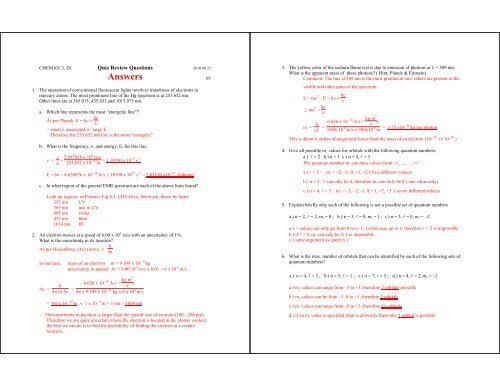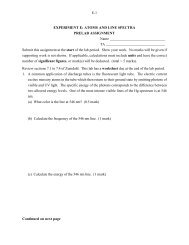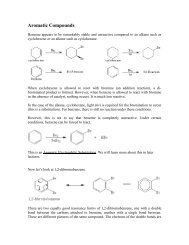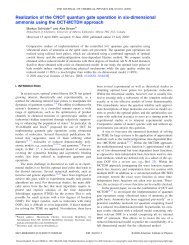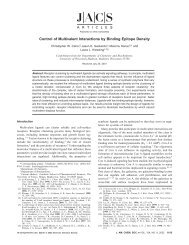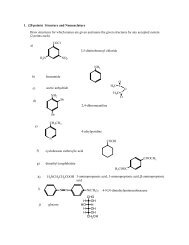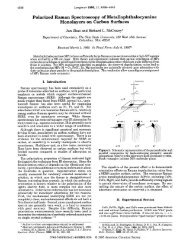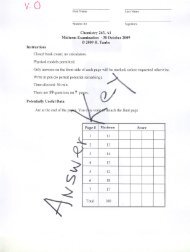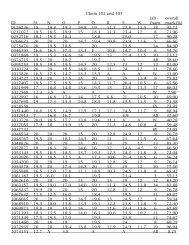Answers to Quiz Review Questions
Answers to Quiz Review Questions
Answers to Quiz Review Questions
- No tags were found...
You also want an ePaper? Increase the reach of your titles
YUMPU automatically turns print PDFs into web optimized ePapers that Google loves.
CHEM101/3, D1 <strong>Quiz</strong> <strong>Review</strong> <strong>Questions</strong> 2010 09 27<strong>Answers</strong>HT1. The operation of conventional fluorescent lights involves transitions of electrons inmercury a<strong>to</strong>ms. The most prominent line of the Hg spectrum is at 253.652 nm.Other lines are at 365.015, 435.833 and 1013.975 nm.a. Which line represents the most “energetic line”?As per Planck: E = hν = hcλ∴small λ associated w/ large E.Therefore the 253.652 nm line is the most “energetic”.b. What is the frequency, ν, and energy, E, for this line.ν = c λ = 2.997925 x 108 m/s253.652 x 10 –9 m = 1.18190 x 1015 s –1E = hν = 6.626076 x 10 –34 Js x 1.18190 x 10 15 s –1 = 7.83136 x10 –19 J/pho<strong>to</strong>nc. In what region of the general EMR spectrum are each of the above lines found?Look up regions in Petrucci Fig 8.3, CDS #6 or, better yet, know by heart:253 nm UV365 nm just in UV405 nm violet435 nm blue1014 nm IR2. An electron moves at a speed of 6.00 x 10 6 m/s with an uncertainty of 1%.What is the uncertainty in its location?As per Heisenberg, (Δx) (Δmv) ≥ h4πIn our case, mass of an electron m = 9.109 x 10 –31 kguncertainty in speeed Δv = 6.00 10 6 m/s x 0.01 = 6 x 10 4 m/sΔx =h4π m Δv =kg m26.626 x 10 -34 Js ( =s)4π x 9.109 x 10 –31 kg x 6 x 10 4 m/s= 9.6 x 10 –10 m ≈ 1 x 10 –9 m = 1 nm = 1000 pm∴ The uncertainty in position is larger than the typical size of an a<strong>to</strong>m (100 - 200 pm).Therefore we are quite uncertain where the electron is located in the a<strong>to</strong>mic context;the best we can do is <strong>to</strong> find the probability of finding the electron at a certainlocation.3. The yellow color of the sodium flame test is due <strong>to</strong> emission of pho<strong>to</strong>ns at λ = 589 nm.What is the apparent mass of these pho<strong>to</strong>ns? ( Hint: Planck & Einstein)Comment: The line at 589 nm is the most prominent one; others are present in thevisible and other parts of the spectrum.E = mc 2 , E = hν = hcλ∴ mc 2 = hcλkg m2m = h 6.626 x 10 -34 Js ( =cλ =s)3.00x 10 8 m/s x 589x10 -9 m = 3.75 x10 –36 kg per pho<strong>to</strong>nThis is about 6 orders of magnitude lower than the mass of an electron (10 –36 vs 10 -30 ).4. Give all possible m l values for orbitals with the following quantum numbers:a.) l = 2 b.) n = 1 c.) n = 4, l = 3The quantum number m l can have values from –l, ...... , +la.) l = 2 : m l = –2, –1, 0, +1, +2 ( five different values)b.) n = 1: l can only be 0, therefore m l can only be 0 ( one value only)c.) n = 4, l = 3 : m l = –3, –2, -1, 0, +1, +2, +3 ( seven different values)5. Explain briefly why each of the following is not a possible set of quantum numbersa.) n = 2, l = 2, m l = 0 ; b.) n = 3, l = 0, m l = 1 ; c.) n = 3, l = 0, m l = -2a.) l values can only go from 0 <strong>to</strong> n–1 ; in this case up <strong>to</strong> 1; therefore l = 2 is impossibleb.) if l = 0, m l can only be 0; 1 is impossiblec.) same argument as under b.)6. What is the max. number of orbitals that can be identified by each of the following sets ofquantum numbers?a.) n = 4, l = 3 ; b.) n = 5, l = 1 ; c.) n = 7, l = 5 ; d.) n = 4, l = 2, m l = –2a.) m l values can range from –3 <strong>to</strong> +3; therefore 7 orbitals possibleb.) m l values can be from –1, 0 <strong>to</strong> +1; therefore 3 orbitalsc.) m l values can range from –5 <strong>to</strong> +5; therefore 11 orbitalsd.) if an m l value is specified (that is allowed), then only 1 orbital is possible
7. What is the shortest wavelength pho<strong>to</strong>n that a an excited H a<strong>to</strong>m can emit?Calculate & Explain.“Shortest wavelength” corresponds <strong>to</strong> largest energy difference; i.e., transition fromoutside the a<strong>to</strong>m (n = ∞) <strong>to</strong> the shell closest <strong>to</strong> the nucleus (n=1). Acc. <strong>to</strong> Bohr:ΔE sys = – R H ( 1 2n– 1 2f n) = – R H ( 1i 1 2 – 1 ∞ 2 ) = – R H = –2.179x10 –18 J/pho<strong>to</strong>n emitted(comment: the minus sign indicates that the system, nucleus and electron, loses energy)Therefore, each emitted pho<strong>to</strong>n has E = 2.179x10 –18 JAcc. <strong>to</strong> Planck (see earlier):λ = hcΔE = 6.626x10 -34 Js x 3.00x10 8 m/s2.179x10 –18 J= 9.12x10 –8 m = 91.2 nm (UV range)10. A ground state H a<strong>to</strong>m absorbs a pho<strong>to</strong>n of wavelength 94.91 nm <strong>to</strong> reach a higherenergy level (excited state). Subsequently, the excited a<strong>to</strong>m returns <strong>to</strong> ground state in a 2-step process by emitting 2 pho<strong>to</strong>ns in sequence. First, an intermediate level is reached byemission of a “1281 nm” pho<strong>to</strong>n. The second pho<strong>to</strong>n is emitted when the electron returnsfrom the intermediate level <strong>to</strong> the ground state.Problem can be solved by repeated application of Bohr & Planck equationsBohr: ΔE sys = – R H ( 1 n f2 – 1 n i2 ) Planck: E ph = hcλNote that for absorption, system energy increases by E ph; i.e., ΔE sys = + E phfor emission, system energy decreases by E ph; i.e., ΔE sys = – E pha.) What higher level did the a<strong>to</strong>m reach? ( n =?)The first step is absorption; thereforeΔE sys = – R H ( 1 n f2 – 1 n i2 ) = E ph ( = hcλ )8. How many orbitals can have the following quantum number or letter designation?Solve for n f (given n i = 1)a.) 3p b.) 4p c.) 4p x d.) n=5 e.) 6d f.) 5d g.) 7sa.) 3 b.) 3 c.) 1 d.) 25 e.) 5 f.) 5 g.) 1Note re d.) n = 5l 0 1 2 3 4m l 0 –1 ...+1 –2 ... +2 –3 ... +3 –4 ... +4orbitals 1 3 5 7 9for a <strong>to</strong>tal of 259. The following are hypothetical situations.a.) What is the “point probability” of finding a 1s electron at a distance y = d if theprobability at x=d is 1x10 -4 ?What is the probability of finding the electron at z = 0.5d, greater or smaller?· s orbitals have spherical symmetrytherefore probability at y = d is the same as at x =d; i.e., 1x10 -4n f ==1– E phR+ 1 2H n i=1– hcλ R H+ 1 1 21– 6.626x10 -34 Js x 2.998x10 8 m/s9.491x10 –8 m x 2.179x10 –18 J= 5.06 ≈ 5During absorption of the exciting pho<strong>to</strong>n, the electron reaches level n = 5 .+ 1· “point” probability increases for 1s electrons as we move closer <strong>to</strong> the nucleus;therefore the probability at z = 0.5 d is greaterb.) Assume that the probability of finding a 2p x electron at x = d is 1x10 -3 . What is theprobability of finding this electron at y=d ?, at z=d ?2p x orbitals have a nodal plane in the yz plane;therefore, the probability at y = d and z = d are both 0
10 b.) What intermediate level was attained? (n f = ?)the second step is emission, thereforeΔE sys = – R H ( 1 n f2 – 1 n i2 ) = – E ph ( = – hcλ ) or11. Write “standard” and “orbital filling” notations for each of the following:a.) Mg, b.) Si, c.) P d.) O 2- , e.) Zn 2+ , f.) Cu, g.) Cr 3+Use the “core” notation. Also write an isoelectronic species for each of the 7 cases.R H ( 1 n f2 – 1 n i2 ) = E phnow with λ = 1281 nm = 1.281x10 –6 m and n i = 5 , we obtain for n fn f =1E phR+ 1 =2H n i1hc+ 1 λ R H 5 2a)b)c)Mg ; [Ne] 3s 2 ; [Ne] ; Al +3sSi ; [Ne] 3s 2 3p 2 ; [Ne] ; Cl 3+3s3pP ; [Ne] 3s 2 3p 3 ; [Ne] ; S +3s3p=16.626x10 -34 Js x 2.998x10 8 m/s1.281x10 –6 m x 2.179x10 –18 J + 1 5 2= 2.999 ≈ 3d)e)O 2 - ; [Ne] ; [He] ; Ne2s2pZn 2+ ; [Ar] 3d 10 ; [Ar] ; Cu +3d10 c.) What is the wavelength of the second pho<strong>to</strong>n emitted?The final step is from level n = 3 <strong>to</strong> level n = 1, obviously emission; thereforef)Cu ; [Ar] 4s 1 3d 10 ; [Ar] ; Zn +4s3dpho<strong>to</strong>n energy, E ph = – ΔE sys = R H ( 1 n f2 – 1 n i2 ) = 2.179x10 –18 J ( 1 1 2 – 1 3 2 )g) Cr 3+ ; [Ar] 3d 3 ; [Ar]; V 2+3d= 1.937x10 18 Jλ = h cE= 6.626x10 -34 Js x 3.00x10 8 m/sph 1.937x10 18 J= 1.026x10 –7 m = 102.6 nm
15. A particular metal surface has a “work function” (binding energy for electrons) =12. How many unpaired electrons are present in∴ Na + < F – < O 2–- < N 3– 3.69 x 10 -19 J. The material is subjected <strong>to</strong> an experiment <strong>to</strong> test the pho<strong>to</strong>electric effect.a.) Ti 2+ b.) Fe 3+ c.) Co 2+ d.) Fe 2+ , e.) Cu+What will be the speed of the emitted electrons if the wavelength of the light used isa.) 300 nm b.) 600 nm?a) Ti 2+ ;; 2 unpaired electrons3db) Fe 3+ ;; 5 unpaired electrons3dλ → energy of pho<strong>to</strong>n → KE of e – → speed of e –a.) ΚΕ = hν – Φ = hcλ – Φ = 6.626x10 -34 Js x 3.00x10 8 m/s300x10 –9 m– 3.69 x 10 -19 Jc) Co 2+ ;; 3 unpaired electrons= 6.62x10 -19 J – 3.69 x 10 -19 J = 2.93x10 -19 J3dKE = 1 2 mev2 → v =2 KEm e1 J = 1 kg m 2 s –2 , me = 9.109x10 –31 kgd) Cu + ;; 0 unpaired electrons3d13. Arrange the following a<strong>to</strong>ms in order of a.) increasing size , b.) first ionization energyv =2 (2.93x10 -19 kg m 2 s –2 )9.109x10 –31 kg= 8.02x10 5 m/sAl, B, C, K, Naa.) size: C < B < Al < Na < K ( K is largest)b.) IE 1 : K < Na < Al < B < C ( C requires the most energy for ionization)b.) pho<strong>to</strong>n energy = hν = hcλ = 6.626x10 -34 Js x 3.00x10 8 m/s600x10 –9 m= 3.31x10 -19 JThis energy is less than the binding energy Φ ; therefore no electrons are emitted.14. a.) Which has the largest (absolute) electron affinity: Se, Cl or Br?“absolute” means the amount of energy released if an electron is capturedThis generally increases left → right, bot<strong>to</strong>m→ <strong>to</strong>p( with noble gases as the mostimportant exception)∴ Cl has the largest absolute EA, has the strongest tendency <strong>to</strong> capture an electronb.) Which has the largest size: O 2- , F - , Fanions are larger than the corresponding neutral a<strong>to</strong>ms;nuclear charge decreases F – → O 2–∴ O 2– has the largest sizec.) Place the following in order of increasing radius: Na + , O 2– , N 3– , F –the four species are isoelectronic; less nuclear charge will cause larger size


